Menus
- G 310 GS, CRF 250 Rally and Versys-X 300
- Conclusion on the entry-level GS
- Honda CRF 250 Rally
- Conclusion on the small rally Honda:
- Kawasaki Versys-X 300
- Conclusion on the adult Versys-X 300:
- MOTORCYCLE test result
- Price comparison of entry-level enduro bikes
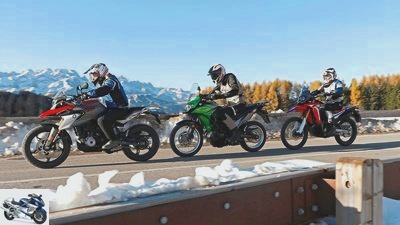

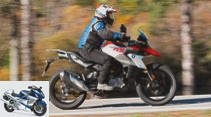
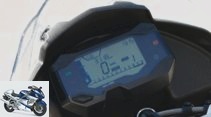
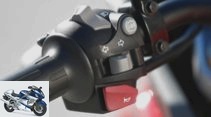
29 photos
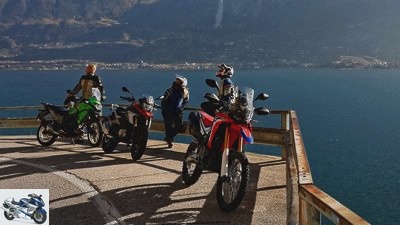
1/29
In the picture from front to back. The Honda only managed 3rd place. In 2nd place comes BMW, which lacks the focus on everyday life. The test winner is the Kawasaki, which offers a lot of space, a long range and good wind protection. A worthy winner apart from the brakes.

2/29
BMW G 310 GS, Kawasaki Versys-X 300 and Honda CRF 250 Rally in comparison test.
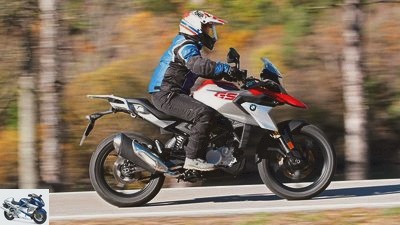
3/29
In terms of price, the BMW in the standard version lies between its counterparts. Cost: 5800 euros.
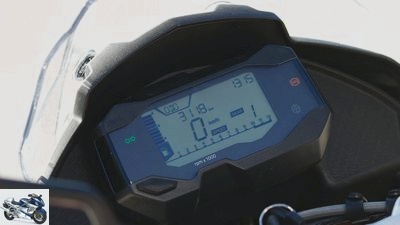
4/29
The cockpit shows all the necessary information at a glance, completely digital. The focus is on speed; Top right time display for coffee breaks.
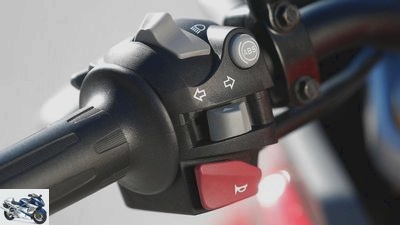
5/29
Practical to use, turn signals, lights and the like are joined by the switch-off button for the ABS.
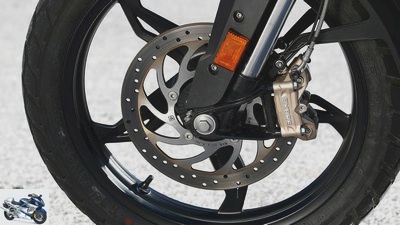
6/29
This is where gold shines: radially mounted Bybre four-piston saddle on a 41 mm upside-down fork.
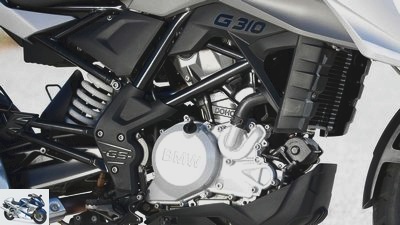
7/29
To shift the center of gravity, the engine tilts noticeably different to the rear; the cylinder head is rotated 180 degrees.
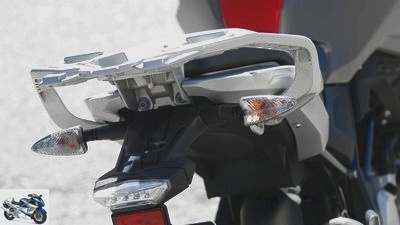
8/29
Smallest height difference between handlebar and seat, tightest seat cushion. It’s sportiest on the BMW.
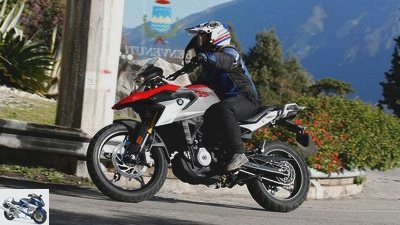
9/29
The BMW lacks enough fuel to take a passenger with you in the long run. The tank holds only 11 liters which is enough for 333 km on the country road.
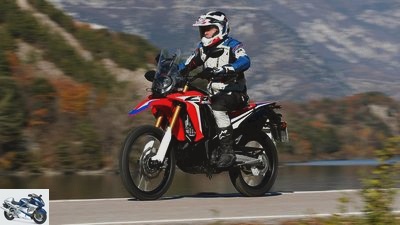
10/29
With 34 hp, it is in the middle of the comparison.
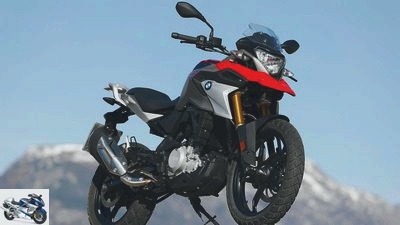
11/29
The compressed version of the GS look is sporty and uncomplicated, but calls for more of the street.
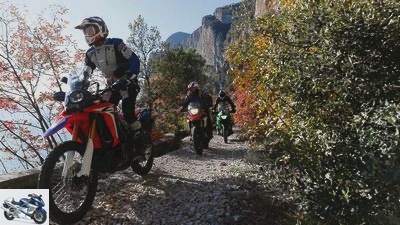
12/29
Roll over small gravel paths on Lake Garda. They can do all three, with the Honda clearly in the foreground here.
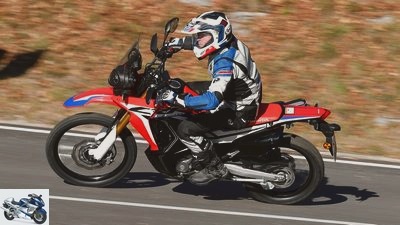
13/29
With a purchase price of 5925 euros, the basic equipment of the Honda is at the upper end of the test.
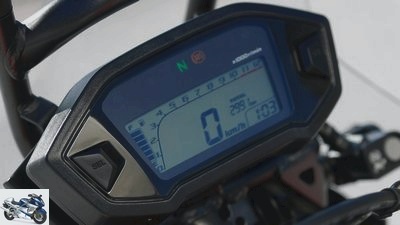
14/29
The cockpit of the CRF is sober, and at least includes a fuel gauge, while a gear indicator is missing.
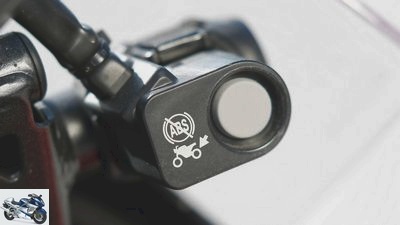
15/29
For off-road adventurers: With the Honda, all you need to do is press a button to switch off the ABS at the rear.
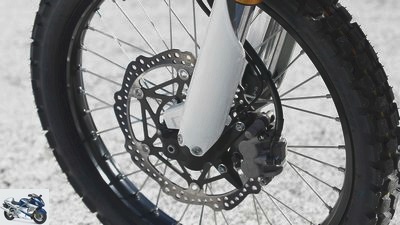
16/29
The double-piston floating caliper and 296 mm wave disc are supposed to guarantee a quick stop, but they don’t always make it.
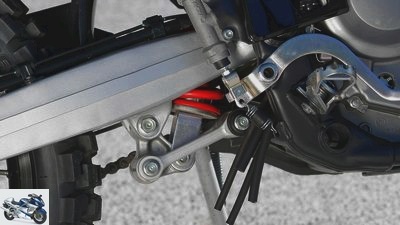
17/29
Like the Versys, the Honda has a deflection on the shock absorber. The BMW does without it.
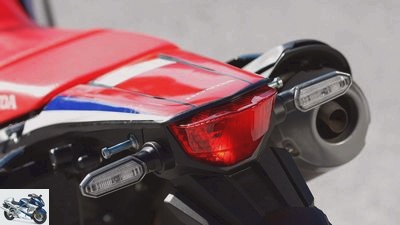
18/29
Space for the pillion passenger? To the ice cream parlor – ok. Until the Dakar rally – probably not.
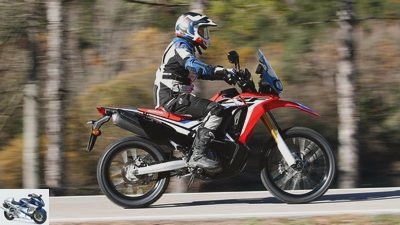
19/29
With a range of 326 km, the Honda comes in last. With a 10.1 liter tank capacity, it’s no surprise either.
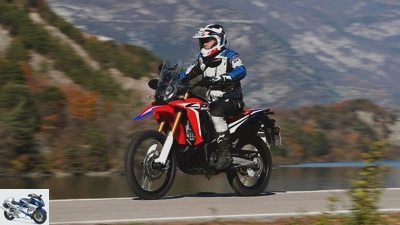
20/29
The single cylinder delivers 25 hp at 8500 rpm. This gives the Honda the weakest engine.
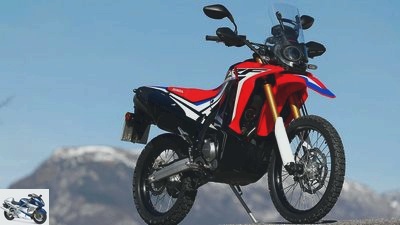
21/29
Where do you go to the next rally stage? The look of the Honda conveys more adventure than the motorcycle can ultimately hold.
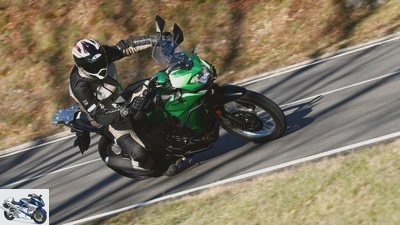
22/29
In the basic configuration, the Kawasaki is the cheapest machine in the field at 5795 euros. With hand protectors, main stand, engine protection bar and tank pad, however, 6424 euros must be placed on the counter. This makes it the most expensive motorcycle in the test.
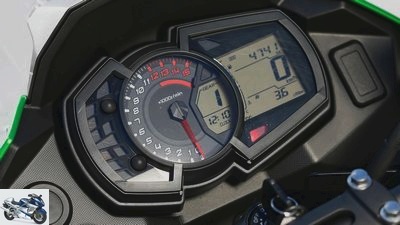
23/29
No other cockpit of the trio offers more information. Remaining range, gear indicator, everything in there and clearly presented.
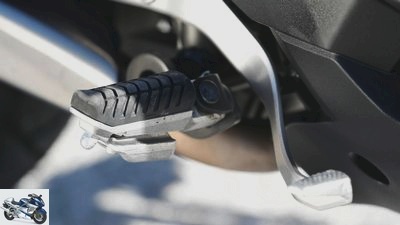
markus-jahn.com
24/29
Foot pegs with vibration dampers. Anyone who has ever shot over 10,000 rpm with the Kawa knows why. It still feels a little tingling.
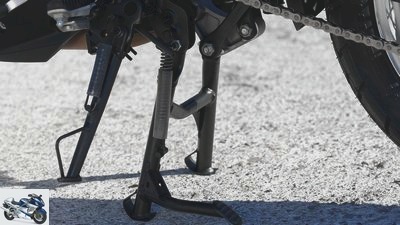
25/29
Not standard, but useful: the main stand makes maintenance and service work easier, costs 274.40 euros extra.
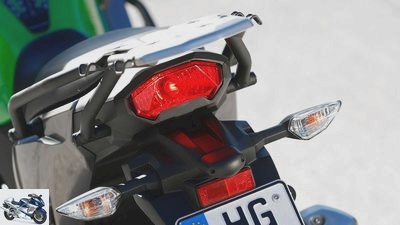
26/29
No other motorcycle offers more seating space than any other – even for the pillion passenger. Shortcoming: the hard upholstery is annoying in the long run.
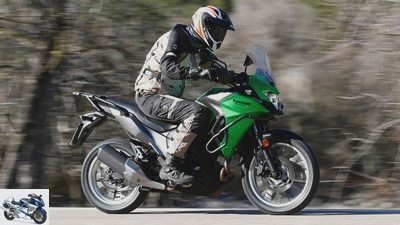
27/29
Largest tank, largest range. 17 liters are enough for a whopping 447 km.

28/29
With 39 hp, the two-cylinder is the most powerful engine in the field.
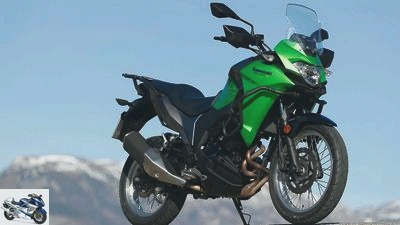
29/29
For a 300, the Versys looks really grown up. The high windshield provides good protection from the wind and the tank connection is narrow.
A2 entry-level enduro bikes put to the test
G 310 GS, CRF 250 Rally and Versys-X 300
Luggage, motorway or gravel – nothing scares off travel enduros. However, most of them weigh over 200 kilos and provide over 100 horsepower. These 3 entry-level enduros want to prove that there are really good travel enduros in the A2 class too.
Of course, it doesn’t work without honesty. When speedy progress on unlimited motorway tracks is on the list, then come the BMW G 310 GS, Honda CRF 250 Rally and Kawasaki Versys-X 300 undoubtedly quickly reaches its limits. With 40 hp, the Kawa from Akashi marks the upper limit of the trio’s performance. But that doesn’t distinguish the three from other entry-level or A2-compatible motorcycles. So sponge over it, ticked off and dedicated to the really important, eventful driving moments. All around Lake Garda, we test what talents the entry-level enduros have. The smallest roads and passes off the main routes such as up to Monte Bondone, the Tremalzopass or around Lago d’Idro and Lago di Valvestino are your territory for a few days.
Buy complete article
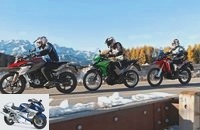
A2 entry-level enduro bikes put to the test
G 310 GS, CRF 250 Rally and Versys-X 300
BMW G 310 GS
As if the BMW G 310 GS could hardly wait for the excursion to this region, it is already scratching with its 19 and 17-inch tires. But be careful: after the start you need a rearward sloping, 313 cm³ single cylinder a few revolutions to hang on to the gas spontaneously. If you do not take this into account, you will stop with a “plop”. After a few meters in the inner-city turmoil of Riva del Garda, however, this has subsided, and the little GS easily wins every traffic light start against the four-wheeled competition. With many identical parts and, above all, spring travel increased to 180 millimeters at the front and rear, the Bavarians have conjured up the sister GS from the small, bare G 310 R. With its more wheelbase and weight, it has lost some of the exuberant handiness of the R, but is still easy to control.
markus-jahn.com
In terms of price, the BMW in the standard version lies between its counterparts. Cost: 5800 euros.
Not unimportant for beginners and, above all, climbers: With the metamorphosis to the BMW G 310 GS, the seat height increased considerably: 860 millimeters are now in the data sheet. Together with the voluminous tank, which spreads the knees a little too widely, and the wide driver’s seat cushion, it is difficult for shorter-term users to get their feet safely on the ground. Alternatively, there is a 15 millimeter lower bench in the BMW range to facilitate this endeavor.
However, this would narrow the knee angle – and this is the most compact on the BMW G 310 GS in this comparison. Whereby the little BMW is struggling a little with the conversion to the travel enduro. With it, the height difference between the wide handlebars and the seat is the smallest, the driver finds the tightest seat cushion. No other of the three is more sporty and collected. Whereby the BMW can capitalize a little on the small roads. She turns the corner casually on the narrow line, ironing out road construction inadequacies in the tar belt with her chest of drawers. In addition, there is the full grip of the mounted Metzeler Tourance, which gives a lot of feedback and trust when savoring the good lean angle. At most, that suffers a little when the brakes are applied. The non-adjustable lever – as with the other two, there are no corresponding adjustment options on the brake and clutch – is less important. Rather, the effect and controllability should be a bit crisper. A wooden feeling remains, especially when the sporty digging on the brakes in turns. In order to save the honor of the fully fueled BMW G 310 GS, which weighs 173 kilograms, it must be said that the other two also have to give up under this point of view, even not reaching the BMW level.
Conclusion on the entry-level GS
What is left at the end of the day? The impression of having sat on the most active of the three motorcycles. However, also on the one that least corresponds to a travel enduro. Although the engine of the BMW G 310 GS turns out to be the best in the comparison, willingly competes below and inspires with a nice thrust across the rev range, with little consumption of 3.3 liters – the GS does not really reveal itself in it. The wind protection is too low for travel stages, the chassis has too few reserves to take a passenger with you in the long run, the tank does not hold enough fuel, the GS spirit is simply missing. With its 35 hp single, the small travel enduro is the sporting cannon among the three and wants to hurry ahead rather than looking for the next adventure.
Honda CRF 250 Rally
That is changing now. Appearance of the Honda CRF 250 Rally. One look is enough: the desert sand gently scurries past the long-legged CRF, attracting the dunes of the Sahara, and where do you go to the Dakar Rally? – Such thoughts whiz through the brain in no time at all. If this isn’t adventure, what is it? Hot HRC look and real Bridgestone Trail Wing studs on the 21 and 18 inch spoke rims. Gravel, we’re coming.
markus-jahn.com
With a purchase price of 5,925 euros, the basic version of the Honda is at the upper end of the test.
Before the thirst for adventure completely prevails before the start, take a quick look at the data: The Honda single-cylinder has only 250 cm³, mobilizes 25 hp, and the pointer of the scale only stops at 158 kilograms, with a full tank. The dynamics seem to have narrow limits. Regardless, the ratio still has to be silent. First, swing your leg over the 900 millimeter high seat of the Honda CRF 250 Rally. 250 millimeters of travel at the front and 265 at the rear take their toll. Once the adventurer sits on it, quite a few of them are already used up. The fork and shock absorber do not have much damping. The spring elements are very soft, even from an enduro point of view.
The same applies to the engine of the Honda CRF 250 Rally. It hangs gently on the gas when the right handle on the cheap-looking steel handlebar with central strut folds against the stop. It may be necessary to fully open the 36 mm throttle valve even in city traffic. This single cylinder lacks vigor. Up to 7,000 revolutions, up to the maximum torque value of 22 Nm, the CRF ignites a small dynamic flame. The fire brigade rushes over and extinguishes the subtle embers in no time. This may be sufficient on the flat or well-groomed enduro hikes, but the limit of propulsion is quickly reached on slight inclines. Proof of this is provided by the performance: With 50 cubic meters less than the competition and a gear ratio that is designed for a top speed of 129 km / h to over 150 km / h, the Honda has to line up at the rear when accelerating and pulling through. On the positive side: Despite a lot of full throttle, it only consumes 3.1 liters over the 100-kilometer distance, the best value in the comparison.
The small Honda CRF 250 Rally reveals even more talents on the tiny mountain passes, turning lightly around every narrow hairpin. The fact that your chassis swings lively, it looks a bit wobbly due to the long spring travel and the knobby tires offer neither feedback nor rolling comfort – for free. To accuse an almost pure-bred enduro like the CRF 250 Rally for consistency would be presumptuous, even if it doesn’t score too many points in the 1,000-point ranking.
The warning index finger can, however, be more visible when it comes to braking. With its 296 millimeter wave disc at the front, the hardware of the Honda CRF 250 Rally is quite good, but the double-piston floating calipers quickly bend their knees. Three to four briskly braked hairpin bends on the pass downhill are sufficient, and the brake swings the white flag and can no longer be decelerated into the ABS control range. It can be adventurous for two, although there is little space for a pillion passenger on the narrow bench.
Conclusion on the small rally Honda:
It’s enough to the next ice cream parlor, not to Africa. The image of the Honda CRF 250 Rally remains ambivalent. As the lightest of the trio, she masters easy gravel passages clearly better than the other two. On the road, however, it falls just as far behind the BMW and the Kawa.
But if you love them, you want to immediately flood the garden with desert sand – even if the apartment only has a balcony. The Honda CRF 250 Rally seems to have sprung from one’s own off-road long-distance travel dream. With its driving dynamics, however, it cannot keep a dreamlike promise for the large, unstable distance.
Kawasaki Versys-X 300
The Kawasaki Versys-X 300 doesn’t want to do that either. In this comparison she emphasizes the aspect of travel. It starts with the seat rehearsal. There is nowhere more space. In addition, the knee joint is nice and narrow despite the 17 liter tank, so your hands reach for the ideally placed handlebars. So everything is suitable for long distances? Almost, because the well-cut seat, which also offers a lot of space for a passenger, embeds the buttocks very hard. That would be fine for a super sports car, the hard upholstery bothers travelers in the long run.
markus-jahn.com
In the basic configuration, the Kawasaki is the cheapest machine in the field at 5795 euros. With hand protectors, main stand, engine protection bar and tank pad, however, 6,424 euros must be placed on the counter. This makes it the most expensive motorcycle in the test.
On the other hand, they like the stable suspension setup of the two-cylinder with its 296 cm³. Regardless of whether you are alone or as a couple, the Kawasaki Versys-X 300 pulls through every bend without couching and never loses its composure. When turning in, however, the tightly tuned fork has a slightly negative effect, because it only sags a little even when braking to the apex. That would encourage the jagged curve dance. However, the Kawa requires the clearest steering commands in order to fold down in an inclined position, drives further lines than the BMW and especially the Honda. Mind you: Taken on its own, the Kawasaki, with its attached accessories such as the main stand and crash bars, weighs 181 kilograms and is still a bustling sweeper finder. Among their peers, they let the chassis set-up, the longest wheelbase, the highest weight and the relatively long caster fall slightly behind.
When it comes to wind protection, however, it moves back to the top position, underlining its suitability for travel. In principle, this would also apply to the engine. After all, it marks the power primus of the trio. However, the small two-cylinder is almost always the screamer. If the smooth clutch – the gentle flapping of a butterfly’s wings is sufficient as operating force – is engaged in gear one, which is just as easy to shift, and the two-man marches forward. Up to 5,000 rpm, it almost gives the impression that a single-cylinder and not a unit with two pistons is at work. But then. From 5,000 revolutions the character changes massively, the barrel organ rules. Always higher, always further. While Honda and BMW brush the sails of just over 10,000 rpm, the governor catches the Versys-X 300 only over 12,000 tours. The display of the Kawasaki often shows high speeds, which is translated briefly. In fourth gear it rotates at 50 km / h in town at 5,000 / min, at 100 km / h in sixth gear the engine speed just passes 7,500, and at the locking engine speed in sixth gear it reaches its top speed of 155 km / h.
Conclusion on the adult Versys-X 300:
The desire for a further gear stage, for a lower speed level, is often present. This tuning arouses the sporting spirit, but also strains, contradicts the travel-ready sovereign character of the Kawasaki Versys-X 300. Otherwise, it convinces almost across the board. There is no more adult travel enduro in this class, and anyway not with more range, which is why the Versys-X 300, like the other two of the trio, proves that real versatility masters can already be found in the A2-suitable travel enduro entry-level segment.
MOTORCYCLE test result
1. Kawasaki Versys-X 300
Lots of space, long range, good wind protection: the Kawasaki emphasizes the aspect of travel and is almost consistently tailored to it. This ensures a bulging point account, offers little room for criticism except for the brakes. A worthy winner.
2. BMW G 310 GS
The abbreviation GS weighs heavily. The expectations were high. And the little GS can’t quite meet them. It’s not the engine. More range, comfort, more focus on everyday life – and then the BMW would be right at the forefront when it comes to music.
3rd Honda CRF 250 Rally
Less travel, more enduro – the Honda implements this claim with no ifs or buts. That turns on, even if it gives away a lot of points. The weakest engine of the trio is too tame even for enduro hiking.
Price comparison of entry-level enduro bikes
Used entry-level enduro bikes in Germany
The three A2 entry-level enduro bikes BMW G 310 GS, Honda CRF 250 Rally and Kawasaki Versys-X 300 are compared directly to one another on the used motorcycle exchange. All three motorcycles are in good condition and at reasonable prices: Used entry-level enduros in Germany
Related articles
-
Comparison test touring enduro bikes: Honda Transalp, Kawasaki Versys, Suzuki V-Strom 650
Jahn comparison test travel enduro: Honda Transalp, Kawasaki Versys, Suzuki V-Strom 650 Always on the wall, travel enduro does not necessarily mean BMW …
-
Enduro comparison – off-road bikes from Beta, Honda, Yamaha and KTM
Monnich 24 pictures Monnich 1/24 With the Freeride 350, KTM is taking responsibility for the off-road scene. The competition: Yamaha WR 250 R, Honda CRF 250 L, …
-
BMW F 800 GT, Kawasaki Z 1000 SX and Honda VFR 800 F in the test
fact 44 photos fact 1/44 fact 2/44 fact 3/44 fact 4/44 fact 5/44 In praise of diversity: the three test candidates all want the same thing, but try to…
-
Comparative test of 450 cc sport enduro bikes
Llurba Comparative test of 450 cc sport enduro bikes All nine D. he highest sales figures, the fastest lap times, the highest priority – the 450 class is…
-
Comparison test Honda XL 600 V Transalp against Kawasaki KLE 500
Comparison test Honda XL 600 V Transalp against Kawasaki KLE 500 Silent stars Never made it big. Others collect prices, they are cheap. Now the late…
-
BMW, Kawasaki, Yamaha and Honda Tourer in comparison
Artist 21st photos 1/21 The story of a seven-day trip with a simultaneous comparative test around the Baltic Sea with the tourers: BMW K…
-
Honda CBF 600, Kawasaki ER-6n, Suzuki Gladius 650 and Yamaha XJ6
Artist Honda CBF 600, Kawasaki ER-6n, Suzuki Gladius 650 and Yamaha XJ6 Comparison test all-rounder Looking for a partner in the world of all-rounders?…
-
Gargolov Comparison test big bikes: Honda CBR 1100 XX Super Blackbird, Kawasaki Ninja ZX-12R, Suzuki GSX 1300 R Hayabusa, Yamaha FJR 1300 A Two fast, two…
-
Comparison test of 400 enduro bikes: Honda XR 400 R, KTM LC4-E 400, Suzuki DR-Z 400 S
Comparison test of 400 enduro bikes: Honda XR 400 R, KTM LC4-E 400, Suzuki DR-Z 400 S straight through Loose over hill and dale? Honda XR 400 R, KTM…
-
Big bikes: Honda CB 1100 F, Kawasaki Z 1000 J and Suzuki GSX 1100 Katana
fact 21st photos fact 1/21 Suzuki GSX 1100 S. fact 2/21 Honda CB 1100 F: Technology Compared to the successful 900 series, the uncovered top model of the…